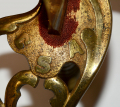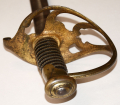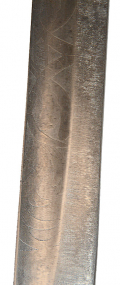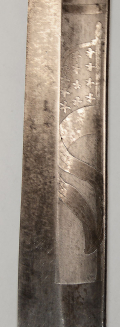site search
online catalog
CONFEDERATE COLLEGE HILL ETCHED BLADE FIELD AND STAFF SWORD AND SCABBARD, OF LT. (LATER CAPTAIN) JOHN B. GALLOWAY, 9th TENNESSEE CAVALRY: “AS LOYAL AND BRAVE A CONFEDERATE SOLDIER AS EVER WORE THE UNIFORM.”

$32,500.00
Quantity Available: 1
Item Code: 846-551
Shipping: Determined by Method & Location of buyer
To Order:
Call 717-334-0347,
Fax 717-334-5016, or E-mail
Once in the collection of well-known collector and author Steve Mullinax, this is one of the nicest College Hill Field and Staff Officer’s Swords out there. The hilt retains lots of original gilt finish, an excellent grip with wire and leather; the blade is etched with a Confederate flag, “C.S.A.” and the officer’s name; the original scabbard has gilt left on the mounts, and bears a partial capture label.
Named after its location in Nashville, TN, the College Hill Arsenal was run by L.T. Cunningham, connected by some sources with Cunningham & Co. of Nashville, who dealt in farm implements and machinery (though we also find a Cunningham connected with firearms.) Cunningham set up operations on College Hill in the Nashville, turning out swords and sabers of all types, selling to the Confederate government, the state, and private individuals until federal forces took the city in April 1862. This sword has the characteristic College Hill high pommel, created by joining the knucklebow to the pommel at its lower edge, and a characteristic lower blade edge that stops short of the guard, giving the impression of a partial ricasso. The blade etching style is also typically College Hill, with loose floral scrolls and vines, and foliate lettering.
The condition of the sword is exceptional. The hilt retains lots of its original gilt finish. The grip is excellent, with original twisted brass wire and the leather grip wrap showing excellent surface and color. The guard even retains the red cloth washer/sealing pad on underside. The guard is complex, with the knuckle bow splitting into obverse and reverse sections below the center of the counterguard, which has a curving edge forming lobes. The obverse branch curves up to join the counterguard at the quillon, flowing into the quillon disk, but has two subsidiary branches, one turning inward to join a branch from the reverse bar at the bottom lobe of the counterguard, forming and open acorn shape, and a second flowing onto the upper obverse lobe of the counterguard. The reverse branch continues above its one split to form a raised edge for the counterguard, which has not only the raised branches showing but also “CSA” in raised block letters above the curving lower edge of the counterguard. The hilt shows some age spotting, but has probably about 40 percent of its subdued gilt finish, with other portions showing a patinaed brass from rubbing and handling.
The blade is very good, with good edge and point. The metal is smooth, showing a mix of bright and silver gray, with fully legible etching in the unstopped, central fuller. Reading from the tip, the blade is etched on the reverse with a long, leafy vine winding down to a large foliate “C.S.A.” followed by a billowing Confederate First National Flag with the three broad stripes and the stars showing in rows. The obverse, also reading point to guard, uses similar floral elements with the officer’s name in middle: “Lt. J.B. GALLOWAY” in large foliate letters filling the width of the fuller.
The scabbard is leather with brass mounts and in good condition. The upper and middle mounts are complete with ring bands and rings. The upper mount shows strong gilt at top and bottom on both sides, with a darker section from rubbing in the middle. The middle mount preserves some in the recesses along the ring band. The drag uses a sea monster curled around the tip as a drag blade and certainly comes from a naval officer’s sword, CS or US, which is not surprising since the campaign against forts Henry and Donelson was an effort to open up the Tennessee and Cumberland rivers. The scabbard body is a mix of medium and dark brown with some staining and crazing to the finish. We see one spot between the upper and middle mounts that may be a mended break. The seam is on the bottom, with a slight gap, but stable and with the stitching in place. Both sides were decorated with double, narrow, incised border lines near the upper and lower edges.
The reverse has the remains of an old, glued capture label in brown ink. The sword had a provenance of coming out of Indiana, so an officer or soldier in the 25th, 31st, 44th or 52nd Indiana would be a prime candidate as the captor. As it stands, the following can be made out: “A C[onfederate…] / found at F[ort Donelson] by … / Bro. i[n] law J[….,]” pretty clearly indicating it was passed along by the captor to a brother in law.
John Brown Galloway was born in 1831 Maury County, Tennessee, and lived his entire (civilian) life there. He married in 1855, and in 1860 was a farmer with a wife and 8-month old daughter, and using Bigbyville as a post office. The couple eventually had at least six children, three of whom survived to adulthood. Galloway seems to have been fairly well-off with real estate valued at $3,000 and a personal estate of $4,750. Enlisting initially in Bradshaw Porter’s company of Tennessee Volunteers, he was elected 2nd Lieutenant of the company on Nov. 11, 1861. The sword likely dates to this point, though Galloway may well have held rank in the company even earlier as a militia unit, with the election merely formalizing his status. They were officially organized as part of the state forces on November 28 and were then organized for Confederate service and mustered in for 12 months on December 23, 1861, at Camp Maury, near Nashville, as one of six companies in Gantt’s 9th Battalion Tennessee Cavalry, and designated as Company B.
The battalion remained in Camp of Instruction until January 16, 1862, when it moved to Fort Donelson. It served as Brigadier General Tilghman’s escort from Fort Donelson to Fort Henry, where it was placed in Colonel A. Heiman’s Brigade, and as part of this brigade, fell back from Fort Henry to Fort Donelson, where Colonel N. B. Forrest was placed in command of all cavalry units. Forrest was not fond of Gantt and particularly irked that Gantt had not gotten regiment out of Donelson before its fall, resulting in the capture of all but Company C on Feb. 16, 1862. Galloway, like the rest, was sent to the prison camp on Johnson’s Island on April 24, and from there on September 1 to Vicksburg for exchange, which took place on Sept. 16, 1862, and he returned to active duty. In the process of reorganizing the regiment he was promoted to 1st Lieutenant on Sept. 24 and then Captain of the company on October 31. The regiment was temporarily consolidated with the 1st Mississippi Infantry until January 1863, when it was remounted. Galloway served with it to the very end of the war, being wounded in action in fighting against Sherman, and was admitted to the CSA General Hospital on Feb. 22, 1865 with a gunshot wound to the “lower extremities.” He was furloughed on March 24, 1865, and was likely recovering at home when the war ended.
An extended regimental history of the unit can be found online, extracted from Tennesseans in the Civil War (1964) and elsewhere. The short version is that they saw action around Port Hudson and various locations in Louisiana in 1863, including several fights with Grierson, and in Mississippi, in Stephen D. Lee’s Cavalry Corps, and in February 1864 they were transferred to the Army of Tennessee, serving under Wheeler and Forrest, before joining Wade Hampton’s cavalry corps in North Carolina, during which service Galloway was wounded. Parole records show the battalion was paroled at Charlotte, North Carolina May 3, 1865.
Galloway returned to Maury County and farming after the war. The 1870 census finds him with his wife and two daughters; the 1880 census shows him with one older daughter who is by then a school teacher, and two younger sons; the 1890 census shows him with wife and one son. His wife passed away in 1903 and at the time of the 1910 census he is still in Maury County, but seems to have moved, living on Hopewell Road in District 6, with his occupation as farmer crossed out and replaced by “none,” and listed as widowed, but living with a son and daughter in law. He died Dec. 23, 1920, an obituary calling him, “as loyal and brave a Confederate soldier as ever wore the Confederate uniform.”
This is an impressive Confederate officer’s sword worthy of a place in any collection. [sr][ph:L]
~~~~~~~~~~~~~~~~~~~~~~~~~~~~~~~~~~~
THIS ITEM, AS WITH ALL OTHER ITEMS AVAILABLE ON OUR WEB SITE,
MAY BE PURCHASED THROUGH OUR LAYAWAY PROGRAM.
CLICK HERE FOR OUR POLICIES AND TERMS.
THANK YOU!
Inquire About CONFEDERATE COLLEGE HILL ETCHED BLADE FIELD AND STAFF SWORD AND SCABBARD, OF LT. (LATER CAPTAIN) JOHN B. GALLOWAY, 9th TENNESSEE CAVALRY: “AS LOYAL AND BRAVE A CONFEDERATE SOLDIER AS EVER WORE THE UNIFORM.”
For inquiries, please email us at [email protected]
Most Popular
Historical Firearms Stolen From The National Civil War Museum In Harrisburg, Pa »
Theft From Gravesite Of Gen. John Reynolds »
Selection Of Unframed Prints By Don Troiani »
Fine Condition Brass Infantry Bugle Insignia »
British Imported, Confederate Used Bayonet »
Piece Of Wood From The Room In The White House Where Lincoln Signed The Emancipation Proclamation »
featured item
RARE WAR OF 1812 SIMEON NORTH U.S. MODEL 1813 ARMY PISTOL
This is a very professional and very well done reconversion to flint of a very hard to find US military pistol, in strong condition, showing very good metal, sharp lock, proof and mating markings, and wood with generally good surface showing the… (431-69). Learn More »




























